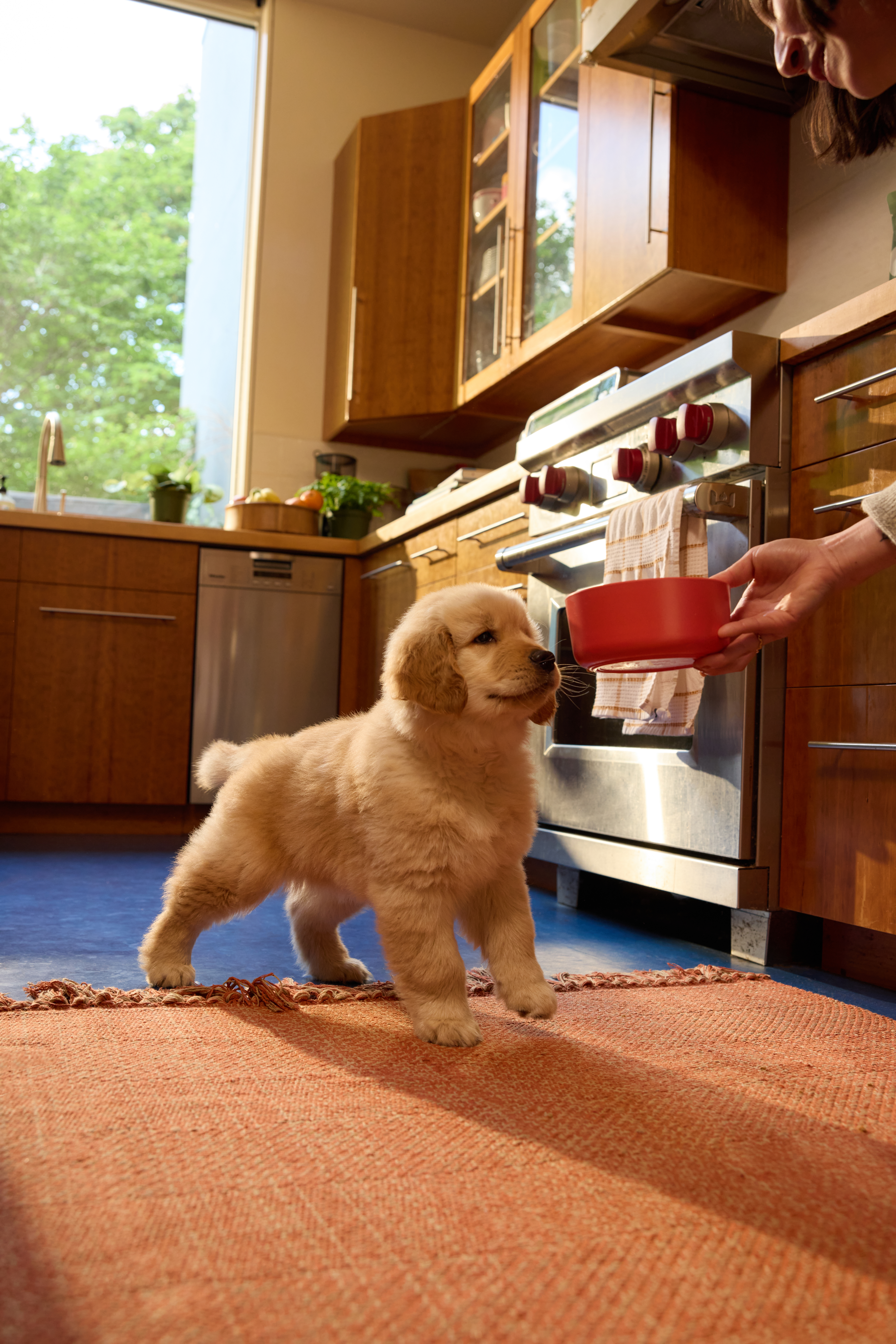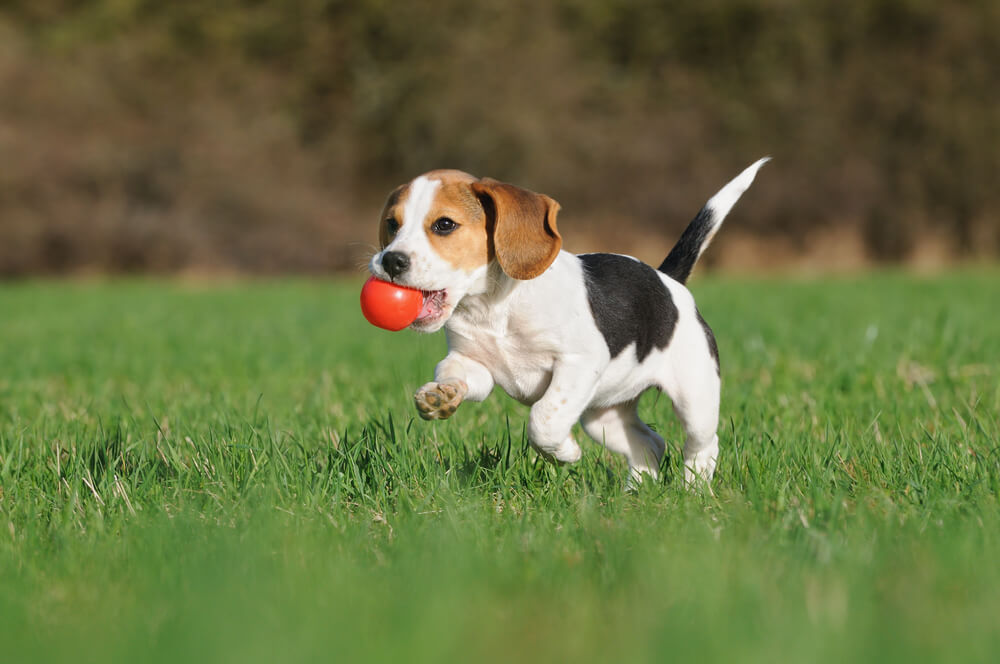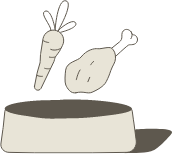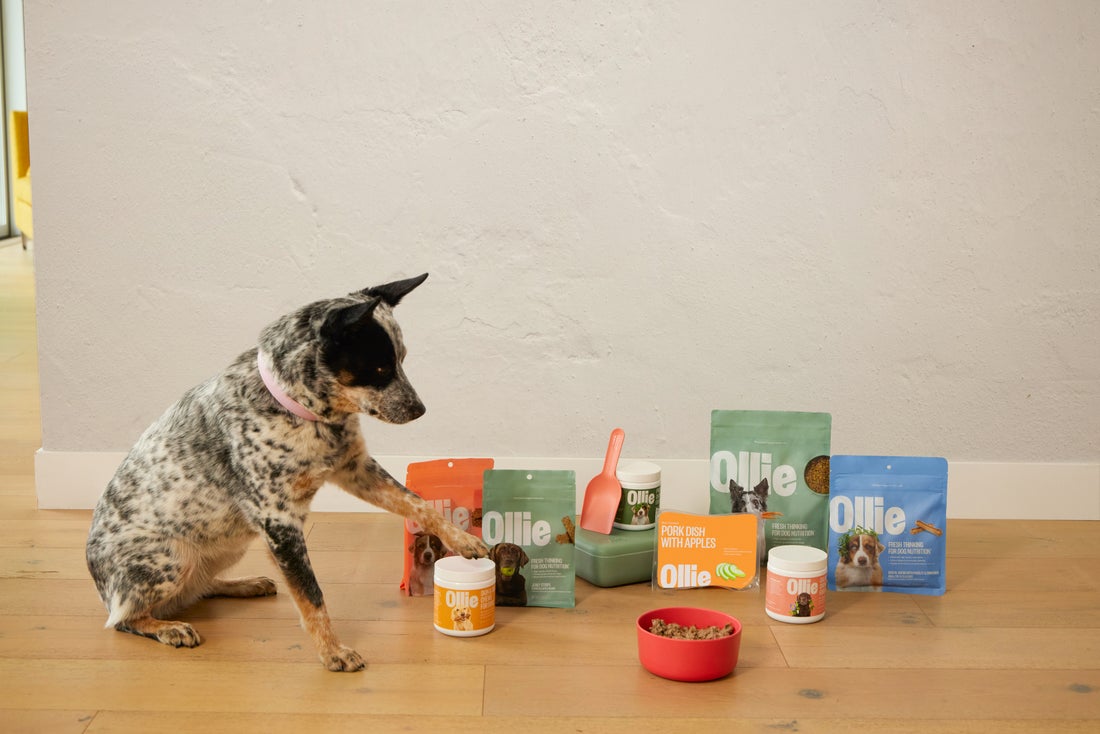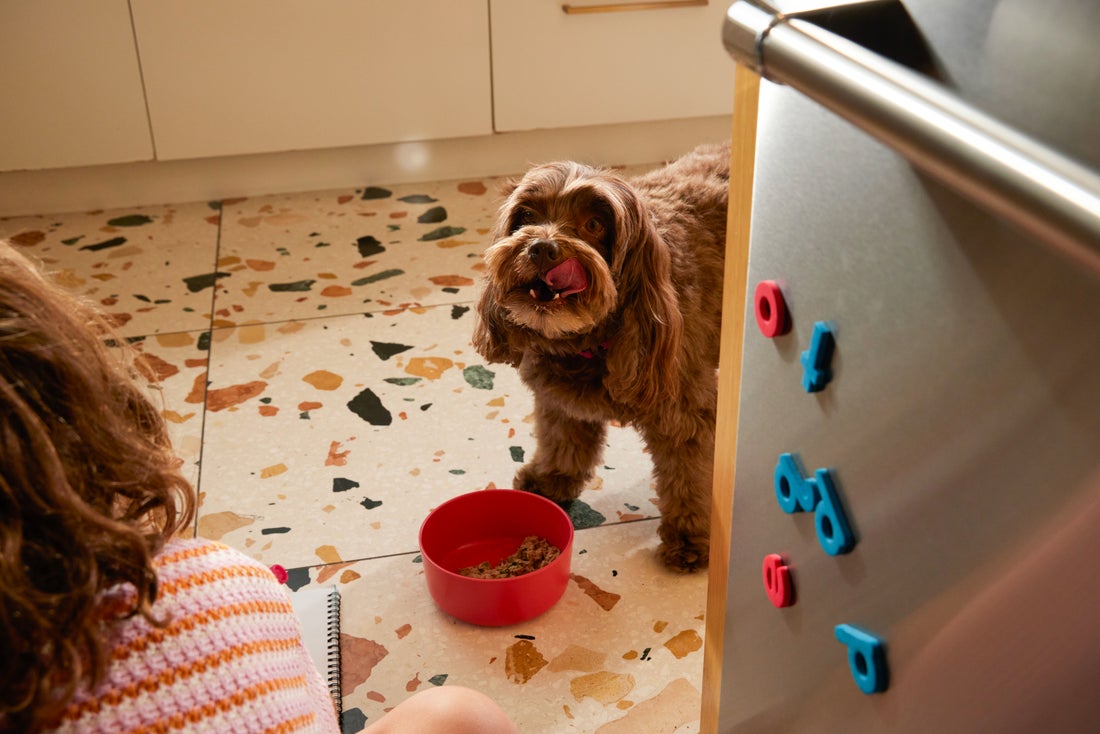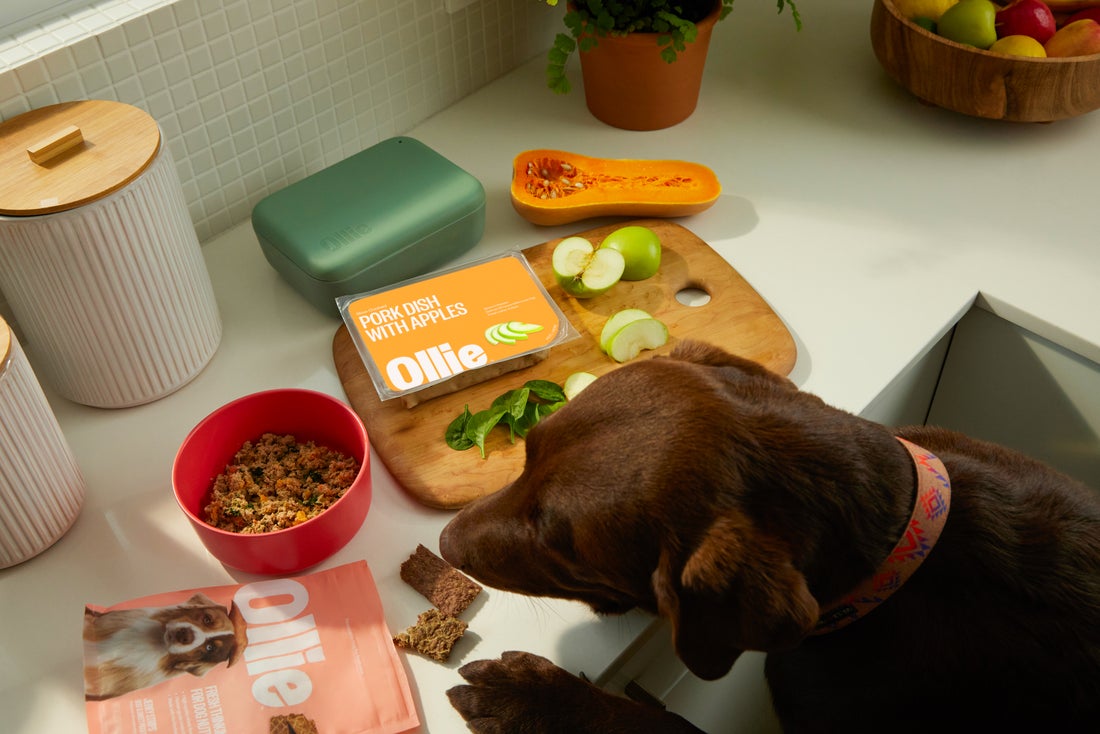Hey Ollie blog readers! We’re offering you an exclusive 60% OFF your starter box! Try now!
As a new pup parent, one of the biggest ways you can support your puppy’s long-term health is by providing the right nutrition. A puppy’s dietary needs are different from an adult dog’s, and getting it right sets the foundation for healthy bones, a strong immune system, and a happy life.
This guide will help you understand how to land on a diet that works best for you pup, from choosing the best food to establishing a feeding schedule that supports their rapid growth.
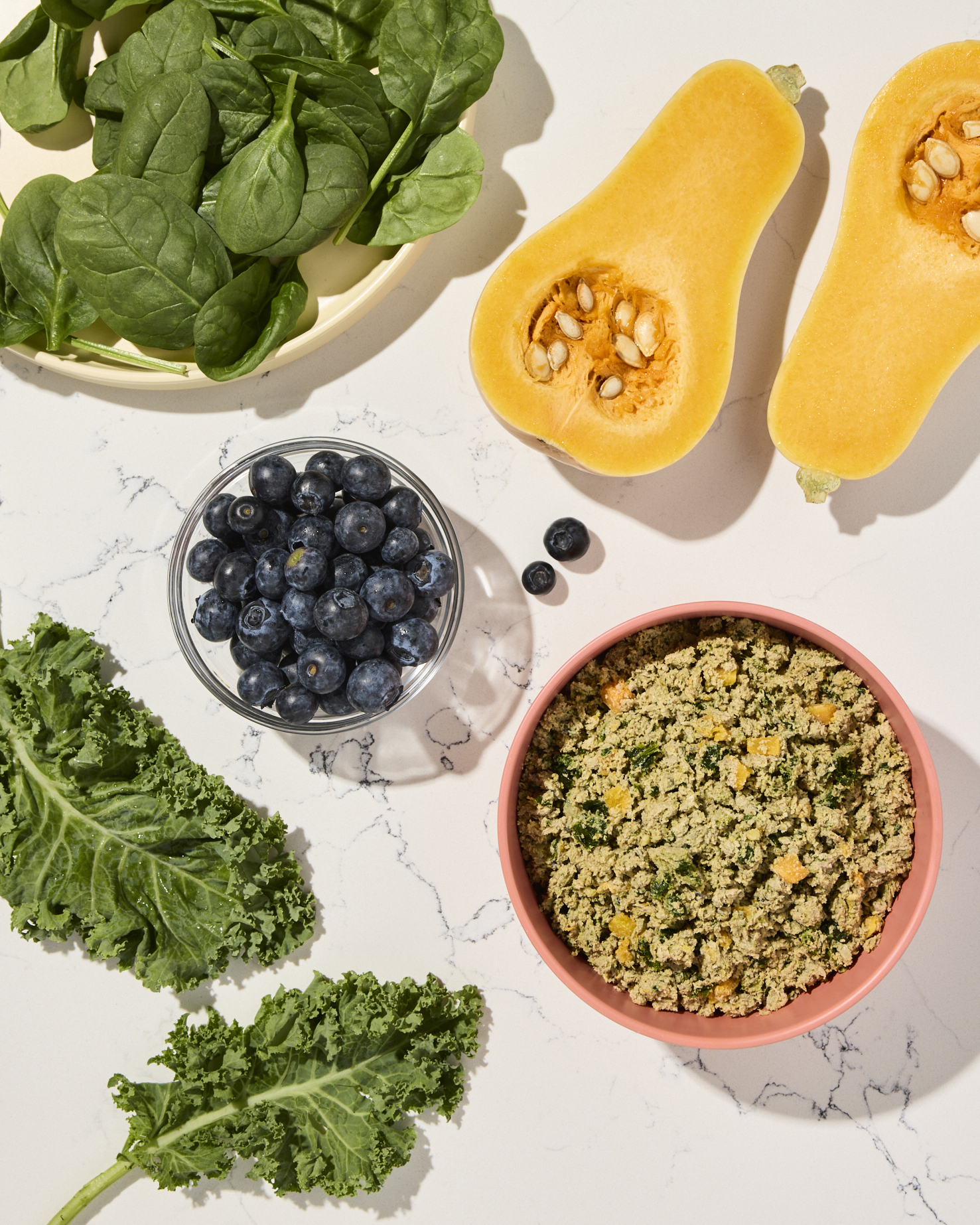
The Building Blocks of Growth: Why Puppy Nutrition Is Unique
You might wonder if you can just feed your new pup a smaller portion of an adult dog’s food. The answer is a firm no. Puppies are undergoing a period of incredible growth and development, and their bodies require a specific balance of nutrients to support this process.
Puppy-specific food is specially formulated to be more nutrient-dense than adult food. It contains higher levels of essential nutrients to fuel their development [1]:
- Higher Protein: To build strong muscles and tissues. Protein requirements are highest right after weaning and gradually decrease as your pup matures [2].
- More Calories and Fat: To provide the energy needed for constant growth and play.
- Key Vitamins and Minerals: Including calcium and phosphorus in the correct ratio for healthy bone and joint development.
Feeding adult food can deprive your puppy of these critical building blocks, potentially leading to developmental issues. A complete and balanced puppy formula is essential for supporting their growing body, developing immune system, and maturing digestive tract [3].
How to Choose the Best Food for Your Puppy
Navigating the dog food aisle can be overwhelming, but knowing what to look for makes it simple. The best food for puppies is one that is complete, balanced, and appropriate for their specific needs.
Look for “Complete and Balanced” Puppy Formulas
Always choose a food that is labeled “complete and balanced” for puppies or for “all life stages” by the Association of American Feed Control Officials (AAFCO). This ensures the food meets the minimum nutritional requirements for a growing dog. Commercial puppy food is the most reliable way to provide your pup with the balanced diet they need [4].
Consider Your Puppy’s Breed Size
Not all puppies are the same. A Great Dane has very different nutritional needs than a Chihuahua.
- Small and Medium Breeds: These pups mature faster and can eat a standard puppy formula.
- Large and Giant Breeds: These puppies require a formula specifically designed for large breeds. This food has a carefully controlled balance of calcium and phosphorus and slightly fewer calories to promote a slower, steadier rate of growth. This controlled growth helps prevent developmental orthopedic diseases, such as hip dysplasia, which can affect large dogs [5].
Fresh Food for Optimal Nutrition
For pup parents seeking to provide the highest quality diet, fresh food can be an option. Fresh dog food uses ingredients that are gently cooked to preserve their nutritional integrity. If you are considering a fresh food diet, consult your veterinarian to ensure it meets all of your puppy’s nutritional needs.
Your Puppy’s Feeding Schedule: How Often and How Much
Consistency is key when it comes to feeding your puppy. A regular schedule not only helps with digestion but also makes house training much easier [6].
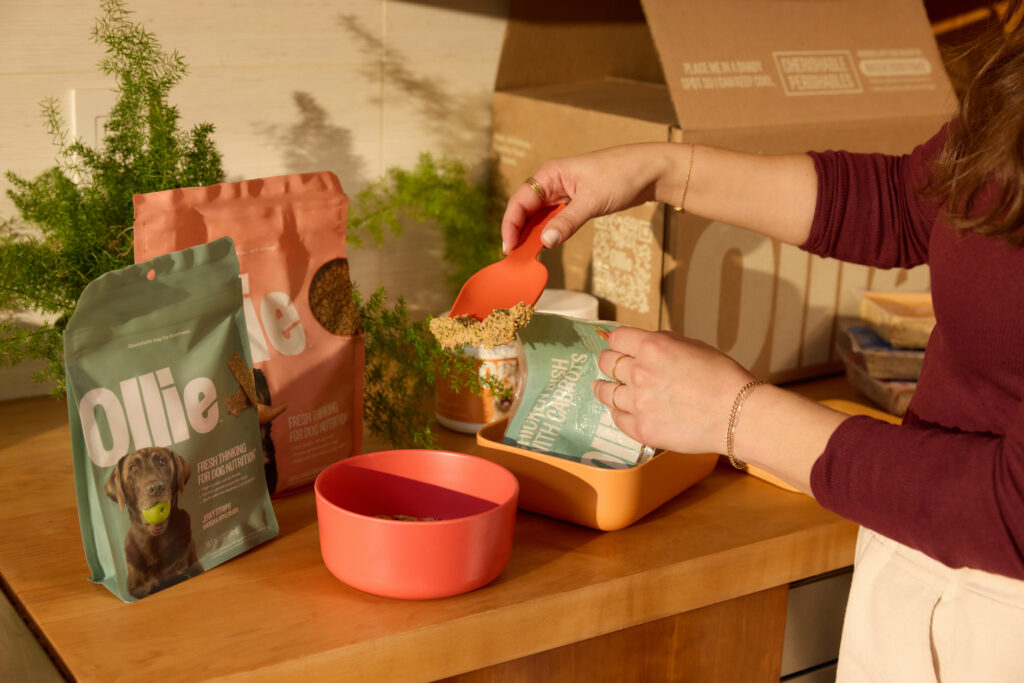
Feeding Frequency by Age
A puppy’s fast metabolism means they need to eat small, frequent meals throughout the day [7]. As they grow, you can gradually reduce the number of meals.
- 6–12 Weeks: Four meals per day.
- 3–6 Months: Three meals per day.
- 6–12 Months: Two meals per day.
This schedule helps maintain stable energy levels and prevents the stomach from getting too full, which can be uncomfortable for a small pup [1], [8].
Determining the Right Portion Size
Portion control is just as important as frequency. Overfeeding can lead to obesity and strain on developing joints, while underfeeding can stunt growth.
The feeding guide on your puppy’s food bag is a good starting point, but remember that it’s just a guideline. You’ll need to adjust the amount based on your puppy’s individual metabolism and body condition [5]. The best way to monitor your pup’s intake is to assess their body condition. You should be able to feel their ribs easily but not see them. They should also have a visible waist when viewed from above. If you have any concerns, your veterinarian can help you create a personalized feeding plan [2].
The Big Switch: Transitioning from Puppy to Adult Food
Your puppy won’t eat puppy food forever. The transition to adult food should happen when they have reached most of their adult size. A good indicator is when they reach about 80% of their anticipated adult weight [2], [4]. The timing varies significantly by breed size:
- Small Breeds: Around 10–12 months.
- Medium Breeds: Around 12–15 months.
- Large and Giant Breeds: Can be anywhere from 15 to 24 months.
It’s always better to keep your pup on puppy food a little longer than to switch too early [1]. When you do make the switch, do it gradually over 7–10 days to avoid digestive upset.
Fueling a Lifetime of Happiness
Providing your pup with the right nutrition is a gift that will last a lifetime. By choosing a high-quality, breed-size-appropriate puppy food, establishing a consistent feeding schedule, and monitoring their growth, you are setting them up for success.
Remember, every puppy is an individual. Pay close attention to your pup’s energy levels and body condition, and never hesitate to consult your veterinarian with questions.
Ready to start fresh? Find your puppy’s recipe for success with Ollie.
Citations
[1] https://www.akc.org/expert-advice/nutrition/puppy-feeding-fundamentals/
[2] https://www.petmd.com/dog/nutrition/how-much-to-feed-puppy
[3] https://www.royalcanin.com/us/dogs/puppy/puppy-feeding-and-nutrition
[4] https://www.chewy.com/education/dog/food-and-nutrition/puppy-feeding-guide
[5] https://www.petmd.com/dog/nutrition/are-you-feeding-your-dog-right-amount
[7] https://blog.myollie.com/how-often-do-you-feed-a-puppy-detailed-guide-for-new-puppy-parents/
[8] https://pupford.com/blogs/all/puppy-feeding-schedule-11-feeding-tips
Tagged As:

The nutrition your dog needs,
the food they want.

Enjoying our articles? Subscribe our Newsletters and get new articles directly to your inbox
You might also like
18 July 2025
6 MINS READ
Can You Mix Fresh Dog Food With Kibble?
If you’re feeding your dog kibble but want to upgrade their bowl, you’re not alone. Many pet parents ask if they can mix fresh dog food with kibble to get some of the benefits of fresh food wi…
by Ollie Pets
18 July 2025
5 MINS READ
Does Fresh Dog Food Help With Weight Loss?
If you’ve noticed your dog carrying a few extra pounds, you’re not alone. According to the Association for Pet Obesity Prevention, over half of dogs in the U.S. are overweight or obese. Extra …
by Ollie Pets
18 July 2025
4 MINS READ
Is Fresh Dog Food Cooked or Raw?
When you hear “fresh dog food,” it’s normal to wonder if that means raw meat or something cooked. After all, fresh just means it’s not dry kibble or canned food packed with preservatives. …
by Ollie Pets
